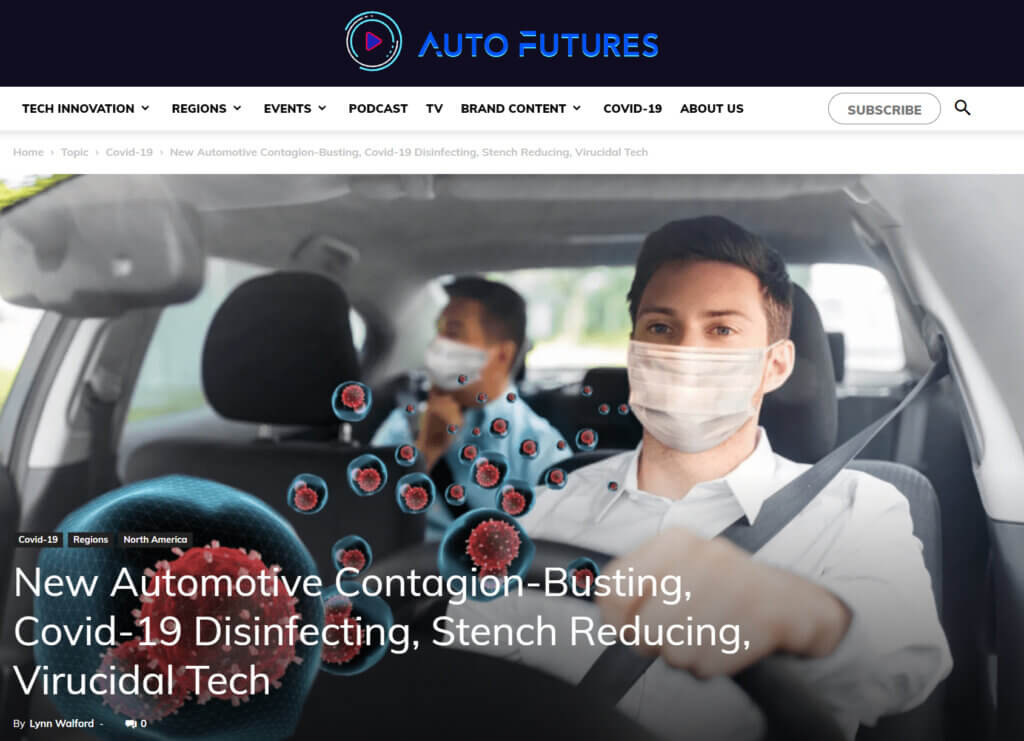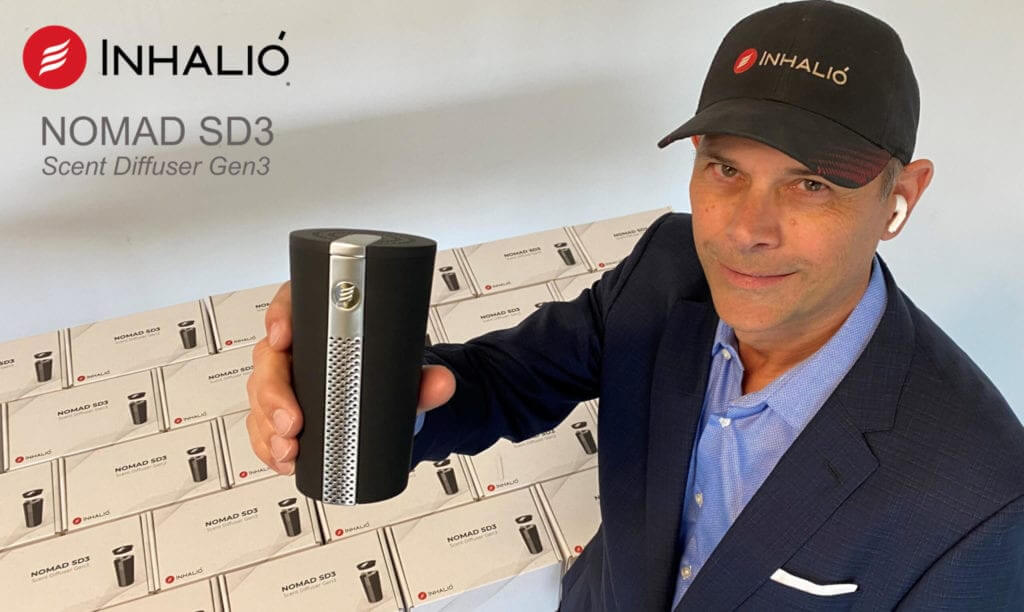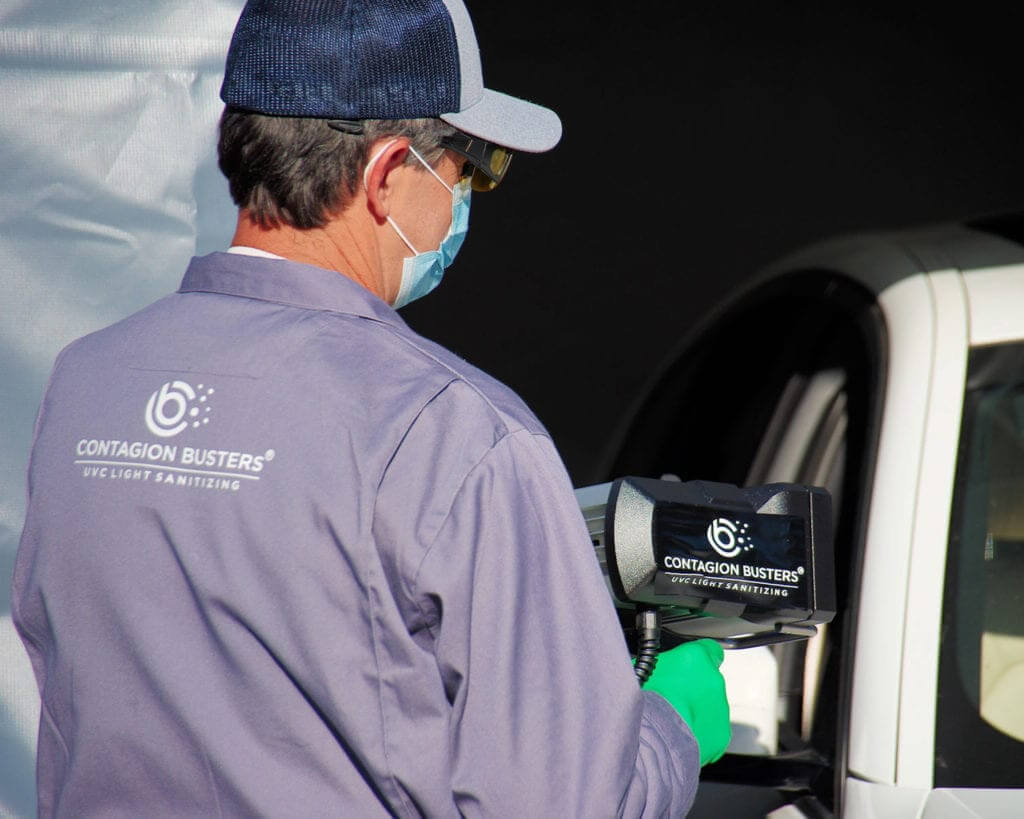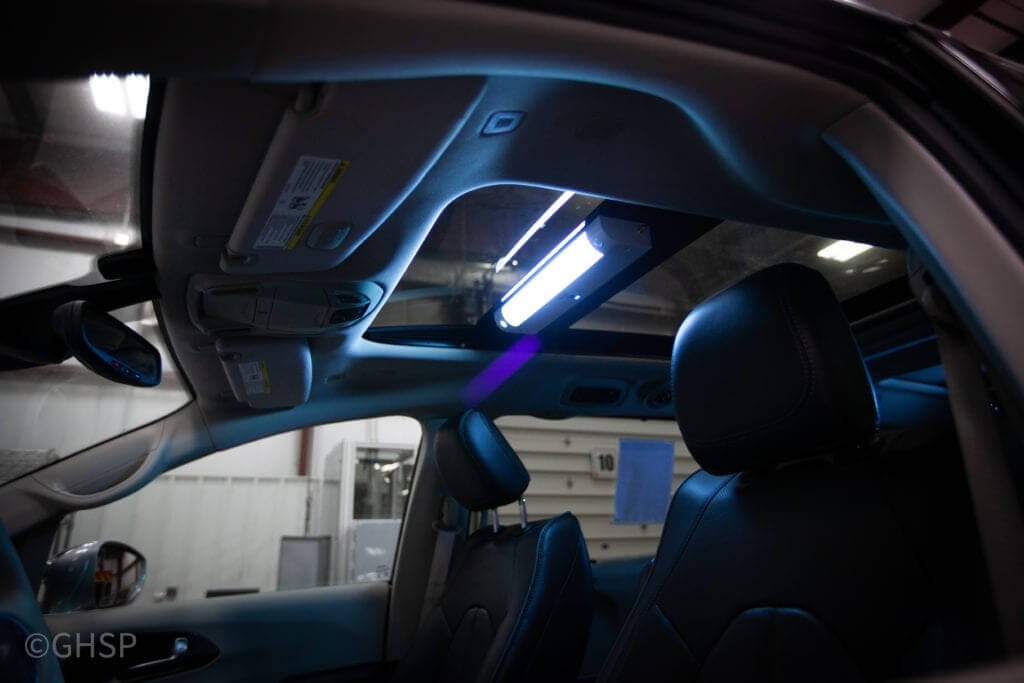New technology is enabling the disinfection of automotive air and surfaces. Auto Futures talks with Inhalio, Contagion Busters and GHSP to learn the details of the technology behind their stench, contagion and virus elimination services. Original Source Article from AutoFutures

Breathe Easier and Happier
A fragrance company, Inhalio, that was already sniffing out new opportunities in the de-scent of gross smells in vehicles, found a natural way to kill airborne odours and viruses. Its cloud-based digital scent technology infuses polymer-encapsulated scent cartridges. When scents are diffused they can kill airborne viruses and bacteria, eliminate bad smells, reduce motion sickness and change moods.
“It’s like television for the nose,” says Keith Kelsen, CEO of Inhalio. He started the company providing smells for Nordstrom and Sephora. The company deployed popular kiosks for McCormick through a game in which customers had to guess the spice smell and found that ‘smells are connected to emotions’.
Inhalio tech is deployed in a vehicle either through a cup-shaped diffuser, Nomad SD3, that sits in the cupholder. Or a diffuser can be embedded in the vehicle’s HVAC system. Using an Inhalio diffuser cartridge, the smell of cigarette smoke can be eliminated in three minutes.
Rideshare drivers will be pleased to learn that the Nomad SD3 can eliminate common bad odours. The company claims to eliminate smells from garbage, urine, seafood, organic acids such as vomit, sweat, mould, mildew, flatulence and defecation, while adding a fresh scent.
Recently, the company started offering a demo kit for automakers with an API to test its capabilities of Rev 3.2 Scent-as-a-Service. Kelsen imagines a future in which before entering an autonomous or rideshare vehicle, the customer can set the preferred scent through an app. When the vehicle arrives, the customer sees an app message notification that the vehicle is scented and ready.
Tests of the Inhalio dry-air diffusion system’s virucidal agent scent formula (V-313485) reduced surrogate airborne viral pathogens by 92.3%, 97.2% and 99.8%, over 30min, 60min, and 120min periods of intermittent release, respectively. There are currently 4,000 units deployed in Europe, enabling customer usage data insights.
“Other kinds of disinfection and sanitation cannot work while the human being is in the vehicle or car,” says Kelsen. However, when asked if he would enter a vehicle with the dry-air infuser with a person known to have a case of Covid-19, Kelsen replied: “It’s not a silver bullet.”
However, he says he would go for a ride if all people were wearing masks with V-313485 diffusing. Due to requests, the company plans on testing the system to see if it will be as effective on cannabis smoke as it has been on tobacco-based smoke.

Contagion Busting Tech
Another option for killing contagions on interior automotive surfaces is a specially designed UVC light developed by Contagion Busters.
“Many leading hospitals sanitize ambulances and operating rooms with UV-C, Ultraviolet light in the 250 nanometers frequency range of sunlight. We found existing UV-C medical equipment to be fast, effective and expensive. What’s more, it was far too fragile to survive the brutal environment of the shop floor,” says John Stevens, Chief Marketing Officer, Contagion Busters.
The company turned to an existing ultraviolet system delivering UV-A and UV-B frequency light in demanding industrial applications. That system was modified and repurposed to sanitizing UV-C frequency light. The result is an automotive sanitizing system that is powerful enough to be fast and effective without chemicals and VOC’s. It is rugged enough to survive the shop environment and at a price below the leading chemical systems, says Stevens.
Stevens sees Contagion Busters deployed in automotive service bays, for car dealerships, car rentals, police cars and fleets. The lights could be used as a paid service or as a ‘lagniappe’ (Southern U.S. Cajun vernacular for an extra perk).
Contagion Busters’ technicians will be trained and required to wear protective lenses and not expose their skin to the UV-C light.

The ability to disinfect according to new kinds of sensors in the car is on our future roadmap.
Last year at CES in Las Vegas, GHSP displayed its grēnlite UV Angel system for ambulances and commercial vehicles. The UV-C light kills 99.9% of viruses and bacteria, including harder-to-kill pathogens such as Clostridium difficile (C. diff) and Human Coronavirus.
The company has partnered with May Mobility and Voyager to disinfect the interiors of fleet autonomous vehicles. The aftermarket GHSP system tracks the locations of vehicle use and emits dosages of UV-C light to disinfect affected areas.
GHSP is now offering ways to use UV-C light systems to disinfect in passenger vehicles. “We are in the process of testing different projects with automakers,” says Marc Smeyers, Chief Technology Officer, GHSP. There has been an interest globally from automakers to integrate grēnlite for a healthier environment, especially in countries in Asia.
The GHSP system uses the current vehicle sensors such as the seat sensors to know what parts of the vehicle have been occupied. It also detects if seatbelt clips or other areas have been touched. Then the UV-C light is emitted to disinfect those areas.
There are additional GHSP UV-C systems for airborne disinfection. UV-C light disinfects the HVAC system. Another option is additional grēnlite UV-C air units in the cabin. The separate units with HEPA filters are used to collect the bad particles out of the air before the air is treated with the grēnlite UV-C light, says Smeyers.
GHSP has been testing grēnlite systems on typical automotive configurations. The UV-C light should not harm the seats or the dash because it has been tested for those types of chemicals currently deployed in vehicles, says Smeyers.

Data and Disinfection
The good thing about grēnlite is that there are no VOC’s or harsh chemicals that can adversely affect the in-vehicle surfaces, says Smeyers. The UV-C light is controlled so that it is not seen by unprotected eyes or exposed to human skin.
Smeyers imagines that the grēnlite disinfection system would be offered as an add-on feature as part of a ‘wellness package’ on new vehicles. It is possible since grēnlite is integrated into the vehicle’s infotainment unit – when the consumer enters there would be a screen showing that the vehicle was disinfected.
An added benefit of the grēnlite being deployed in cloud-connected vehicles would be disinfection based on community data. Then the UV-C light disinfection will be calibrated for that specific pathogen in the area. GHSP is in the process of testing different kinds of in-vehicle sensors.
“The ability to disinfect according to new kinds of sensors in the car is on our future roadmap,” notes Smeyers.
Author : Lynn Walford for AutoFutures.tv
